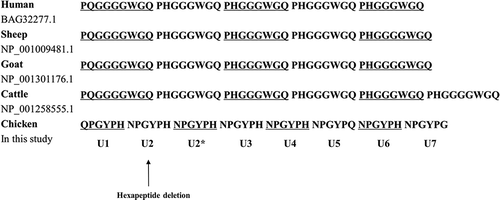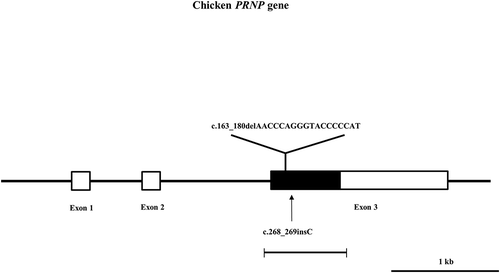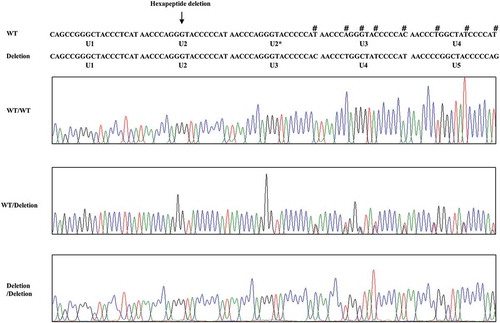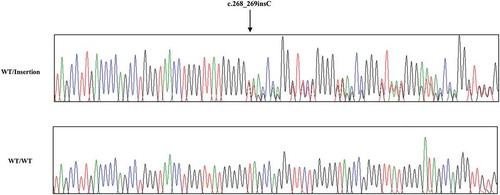Figures & data
Table 1. Genotype and allele frequencies of the PRNP polymorphisms in chickens.
Figure 1. Comparisons of tandem repeat sequence in humans, sheep, goat, cattle and chicken. Tandem repeat sequences were obtained from GenBank at the National Center for Biotechnology Information (NCBI), including those of human (Homo sapiens, BAG32277.1), sheep (Ovis aries, NP_001009481.1), goat (Capra hircus, NP_001301176.1), cattle (Bos taurus, NP_001258555.1) and chicken (Gallus gallus, in this study). Arrows indicate the hexapeptide deletion polymorphism found in this study. Hexapeptide repeat units were named from U1 to U7 in turn. Word spacing and underlines discriminate consecutive tandem repeat units.

Figure 2. Gene map and polymorphism identified in the chicken prion protein gene (PRNP) on chromosome 22. The open reading frame (ORF) is indicated by a shaded block and the 5ʹ and 3ʹ untranslated regions (UTRs) are indicated by white blocks. Horizontal bars with edges indicate the regions sequenced. Arrows indicate the polymorphisms found in this study. The Y-shaped bar indicates the hexapeptide deletion polymorphisms identified in the chicken PRNP gene.

Figure 3. Electropherogram of hexapeptide deletion polymorphism in chicken PRNP gene. Four colors indicate individual bases of DNA sequence using ABI 3730 automatic sequencer (blue: cytosine, red: thymine, black: guanine, green: adenine). Sharps (#) indicate double peaks induced by hexapeptide deletion polymorphism. Arrows indicate the hexapeptide deletion polymorphism (U2) found in this study. WT: wild-type of chicken hexapeptide repeat. Deletion: U2 deletion polymorphisms of chicken hexapeptide repeat.

Figure 4. Electropherogram of c.268_269insC polymorphism in chicken PRNP gene. Four colors indicate individual bases of DNA sequence using ABI 3730 automatic sequencer (blue: cytosine, red: thymine, black: guanine, green: adenine). Sanger sequencing was performed by reverse gene-specific primer, as described in the materials and method section. Arrows indicate c.268_269insC polymorphism found in this study. Upper portion: heterozygote of c.268_269insC polymorphism. Lower portion: wild-type of the chicken PRNP gene sequence. WT: wild-type of the chicken PRNP gene sequence. Insertion: c.268_269insC polymorphisms of the chicken PRNP gene sequence.

Figure 5. Electropherogram of the chicken PRNP region encompassing hexapeptide deletion and c.268_269insC polymorphisms in sample #44. Clone 1: Electropherogram showed wild-type sequences in hexapeptide deletion and c.268_269insC polymorphisms from the sample #44. Clone 2: The deletion sequence in hexapeptide deletion polymorphism and the insertion sequence at c.268_269insC polymorphism from the sample #44. Arrow indicates c.268_269insC polymorphism found in this study.

Table 2. Linkage Disequilibrium (LD) among two polymorphisms of PRNP in chickens.
Table 3. Haplotype frequency of two PRNP polymorphisms in chickens.
Table 4. Prediction of protein functional alteration induced by deletion polymorphism of the chicken prion protein using PROVEAN.
